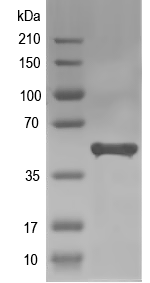Protein expression services for Kcnj16 | Inward rectifier potassium channel 16
Description
Inward rectifier potassium channels are characterized by a greater tendency to allow potassium to flow into the cell rather than out of it. Their voltage dependence is regulated by the concentration of extracellular potassium; as external potassium is raised, the voltage range of the channel opening shifts to more positive voltages. The inward rectification is mainly due to the blockage of outward current by internal magnesium. KCNJ16 may be involved in the regulation of fluid and pH balance (By similarity). In the kidney, together with KCNJ10, mediates basolateral K(+) recycling in distal tubules; this process is critical for Na(+) reabsorption at the tubules.
Family
Belongs to the inward rectifier-type potassium channel (TC 1.A.2.1) family. KCNJ16 subfamily.
Species
Rattus norvegicus
Length
419 amino acids
Sequence
MSYYGSSYRIVNVDSKYPGYPPEHAIAEKRRARRRLLHKDGSCNVYFKHIFGEWGSYMVDIFTTLVDTKWRHMFVVFSLSYILSWLIFGSIFWLIALHHGDLLSDPDITPCVDNVHSFTAAFLFSLETQTTIGYGYRCVTEECSVAVLTVILQSILSCIINTFIIGAALAKMATARKRAQTIRFSYFALIGMRDGKLCLMWRIGDFRPNHVVEGTVRAQLLRYSEDSEGRMTMAFKDLKLVNDQIILVTPVTIVHEIDHESPLYALDRKAVAKDNFEILVTFIYTGDSTGTSHQSRSSYVPREILWGHRFHDVLEVKRKYYKVNCLQFEGSVEVYAPFCSAKQLDWKDQQLNNLEKTSPARGSCTSDTNTRRRSFSAVAMVSSCENPEETSLSPQDECKEVPYQKALLTLNRISMESQM
Mass
47.9 kDa
Simulated SDS-PAGE
 (Note: Representative image - actual molecular weight may vary depending on tag type and expression method)
(Note: Representative image - actual molecular weight may vary depending on tag type and expression method)Safety
Upon ordering, we will perform rigorous biosecurity and export control screening to ensure that order fulfillment is consistent with all legal and regulatory guidance.
Protein synthesis service
Make Kcnj16 using our protein expression services starting at $99 + $.30/amino acid in as fast as two weeks (includes the cost of DNA synthesis)
Order Here